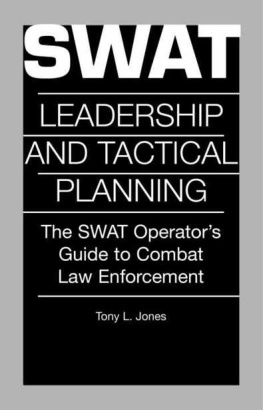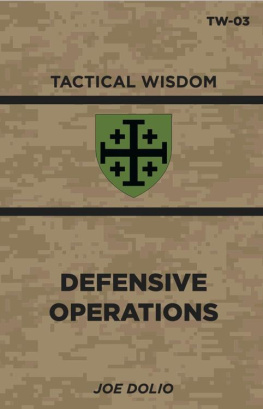

This book is dedicated to all SWAT team leaders who have experienced the trials and triumphs of tactical leadership.







Chapter 1: 1
Flexible in Technique
Personal in Application
Decisiveness
Initiative
Qualification
Chapter 2: 9
SWAT Commander Duties
Sniper Commander Duties
Sniper Leader Duties
SWAT Team Leader Duties
Sniper Duties
Team Member Duties
Team Organization
Team Member Responsibilities
Team Position Selection
Weapons Placement
Weapon Choices
Pyrotechnics
Sight System Enhancers
Chapter 3: 31
Control, Security, and Speed
Basic Tactical Formations
Team Movement
Team Movement Under Fire
Coordinated Weapons Fire on Target
Lightly Armored Vehicles
Frequently Encountered Tactical Conditions
Chapter 4: 69
Analyze the Mission
Initial Tactical Actions
Warning Order
Briefing
Tactical Chain of Command
Tactical Operations Center
Field Command Post
SWAT Commander
Sniper Commander
First-Line Supervisors
Operational Entities
Information-Gathering Methods
Hostage, Suspect, and Team Considerations
Operations Order
Warning Order and Operations Order Differences
Debrief
Mission Success
Chapter 5: 103
Weapons
Load-Bearing Equipment
Scheme of Maneuver
General Tips


 he intent of this book is to assist all tactical entities and operators in planning a successful mission. Desirable leadership traits, command structure, position duties, team configuration, weapons choice and placement, team movement and control, the planning process, warning order, Emergency Operations Center (EOC), Tactical Operations Center (TOC), field command post, intelligence sources, mission considerations, operations order, debriefing, and tactical tips are covered.
he intent of this book is to assist all tactical entities and operators in planning a successful mission. Desirable leadership traits, command structure, position duties, team configuration, weapons choice and placement, team movement and control, the planning process, warning order, Emergency Operations Center (EOC), Tactical Operations Center (TOC), field command post, intelligence sources, mission considerations, operations order, debriefing, and tactical tips are covered.
I have observed many federal, state, city, and county organizations disregard planning or, more frequently, inadequately plan tactical missions. Sometimes urgency and condensed time events were cited as excuses, or more often the belief that planning isn't necessary was obvious. Either excuse demonstrates the lack of training in planning tactical missions.
Tactical planning is a life insurance policy of sorts. Medical support will be planned and staged for expedience in the event that a SWAT operator, hostage, or suspect requires immediate attention. Identification of mixed departments will be delineated to avoid friendly fire situations. Planned routes of approach and assault will be identified to avoid friendly fire and cross fire situ ations. Personal reaction time will be heightened by knowing what to do instead of guessing what to do. Planning readily identifies mission scope and chances of success as weighed by team strength and capabilities.
Tactical planning is a useful investigative tool when reconstructing the scene is required. A well-planned mission will avoid the criminal, civil, and social difficulties a poorly planned mission breeds. Tactical planning can be used to develop solutions to similar situations in the future.
Statements may be made citing the age-old theme, "We have never used formal planning before, so why start now?" A good analogy of this is, "If you have never used your weapon, why carry it?" In tactical planning, small unit leadership traits must be utilized in order to cultivate an effective plan, and subordinate participation is critical. Tactical planning is a team effort that ensures understanding, promotes confidence in mission accomplishment, and fosters professionalism.
It is critical to plan from the beginning to the end for all tactical situations. Even if a tactical solution isn't required, practice and real-world training will be realized. File all plans for possible future reference should a similar tactical situation come up. Plan thoroughly and execute the plan with required surprise, speed, and violence of action. If one or more of the elements of surprise, speed, or violence of action is compromised, consider aborting the mission. SWAT member survival and mission success depend on it.



 apoleon's view of leadership was clear: "There are no poor units, only poor commanders." I know this sounds harsh, but the concept is inescapably true. Remember this above all else: "A leader can delegate his authority, but he can never delegate his responsibility." The chain of command from the EOC commander to the team leader will be held responsible for all of their subordinates' actions and mission outcome.
apoleon's view of leadership was clear: "There are no poor units, only poor commanders." I know this sounds harsh, but the concept is inescapably true. Remember this above all else: "A leader can delegate his authority, but he can never delegate his responsibility." The chain of command from the EOC commander to the team leader will be held responsible for all of their subordinates' actions and mission outcome.
A leader who dodges responsibility and blames others for mission failure chooses the coward's route. Team members will note these actions, never forget them, and never trust this leader again! Everyone knows that the leader is human and not infallible. The leader must accept this and remember it. He will gain the respect and loyalty of team members by accepting responsibility for actions performed under his or her span of control.
SWAT leaders will discover a wealth of guidance on leadership traits by researching the various military branches. However, don't forget that the leader is responsible for leading a small paramilitary team, so he must place a civilian twist on a military concept. To obtain an effective balance, the leader must be flexible in technique and personal in application.
Next page


















 he intent of this book is to assist all tactical entities and operators in planning a successful mission. Desirable leadership traits, command structure, position duties, team configuration, weapons choice and placement, team movement and control, the planning process, warning order, Emergency Operations Center (EOC), Tactical Operations Center (TOC), field command post, intelligence sources, mission considerations, operations order, debriefing, and tactical tips are covered.
he intent of this book is to assist all tactical entities and operators in planning a successful mission. Desirable leadership traits, command structure, position duties, team configuration, weapons choice and placement, team movement and control, the planning process, warning order, Emergency Operations Center (EOC), Tactical Operations Center (TOC), field command post, intelligence sources, mission considerations, operations order, debriefing, and tactical tips are covered.


 apoleon's view of leadership was clear: "There are no poor units, only poor commanders." I know this sounds harsh, but the concept is inescapably true. Remember this above all else: "A leader can delegate his authority, but he can never delegate his responsibility." The chain of command from the EOC commander to the team leader will be held responsible for all of their subordinates' actions and mission outcome.
apoleon's view of leadership was clear: "There are no poor units, only poor commanders." I know this sounds harsh, but the concept is inescapably true. Remember this above all else: "A leader can delegate his authority, but he can never delegate his responsibility." The chain of command from the EOC commander to the team leader will be held responsible for all of their subordinates' actions and mission outcome.